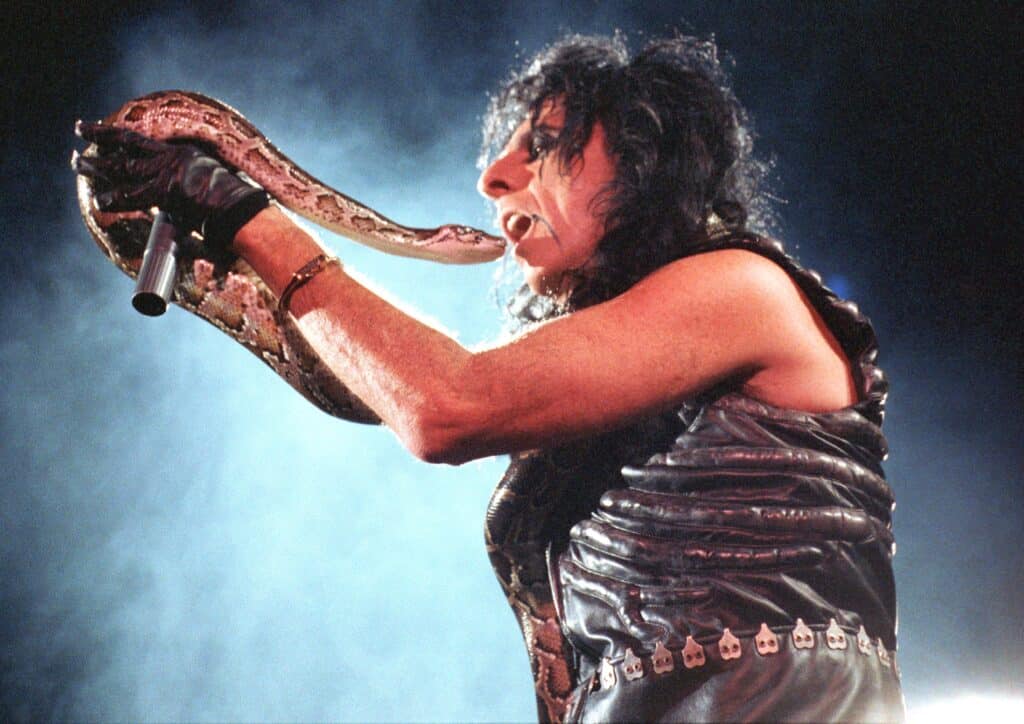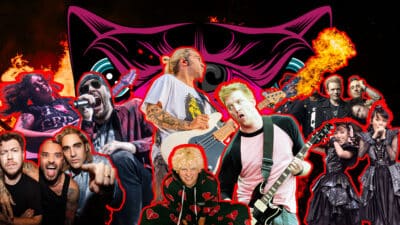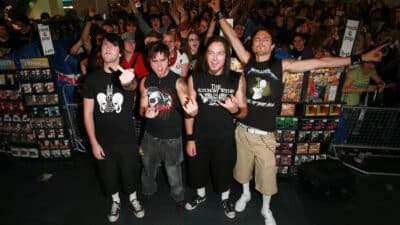Feature

Feature
Screams and shredding: a brief history of heavy metal and horror
With Halloween just around the corner, we untangle the unholy union of heavy metal and horror, where terror reigns supreme
Countercultural, provocative and often controversial – heavy metal music and horror films have a lot in common.
Since metal’s inception over half a century ago, a symbiotic relationship has existed between the two subgenres – evolving alongside societal fears, cultural shifts and artistic innovations. This eerie alliance has manifested in various forms throughout the history of metal music, with each era bringing its own unique shade of darkness.
From the occult-laden sounds of Black Sabbath to the theatrical storytelling of modern bands such as Creeper and Ice Nine Kills, metal and horror have consistently pushed boundaries, challenged norms, and provoked thought. Guiding and shaping each other in the darkest of ways, it’s time to delve into the history of a match made in hell.
The birth of darkness

In the dimly lit recesses of the 1970s, a musical revolution was brewing – where the ominous threads of metal music intertwined seamlessly with the eerie tapestries of horror. In the same decade that films such as The Exorcist (1973) and Halloween (1978) captivated audiences, Black Sabbath, emerged as the torchbearers of a new era.
Named after a 1963 Mario Bava horror anthology, their eponymous 1970 debut album brought lyrics steeped in occult symbolism and melodies shrouded in darkness – its opening track inspired by a demonic visitation reportedly experienced by bassist Geezer Butler. Crafting heavy, doom-laden riffs alongside lyrics that delved into realms of devils, demons, and otherworldly creatures, Sabbath’s arrival saw the macabre meet musicality in an unholy matrimony, laying the groundwork for a genre that would go on to delve even further into the darkest corners of the human imagination.
Amidst this musical transformation, another enigmatic figure was emerging – Alice Cooper, the Godfather of Shock Rock. Splitting with his original band and launching the second phase of his career with 1975’s Welcome To My Nightmare, Cooper’s performances were not mere concerts; they were spectacles. Stages transformed into a horrifying carnivals where guillotines descended, and fake blood flowed freely, blurring the boundaries between reality and nightmare. Inspired by Grand Guignol theatre and horror imagery, Cooper’s shows were laden with staged tortures and executions, electric chairs, gallows, and even giant snakes. With a theatricality that knew no bounds, the singer popularised the use of horror imagery in heavy music, making his carnival-of-terror live shows just as entertaining and thrilling as the horror movies that were darkening in the cinemas.
The Satanic Panic

As metal and horror ventured further into the 80s, the connection between the two grew stronger still. On screen, slasher movies and elaborate gore effects pushed the boundaries of fear, and bands such as Judas Priest, Motörhead, and Venom took a parallel path. Embracing a more brutal approach, this era heralded a more intense, visceral experience, with metal music becoming a vehicle for exploring the depths of human terror.
By the mid-80s – whilst A Nightmare On Elm Street (1984) and Hellraiser (1987) captivated horror fans – the rebellious spirit of metal music was fuelling a moral hysteria, famously known as “the satanic panic”. During this tumultuous period, metal became the target of societal fear, accused of corrupting the youth with its dark themes and imagery.
Kickstarted by Michelle Smith’s claims that she had been abused by the Church of Satan in her 1980 book, Michelle Remembers, the panic led to the 1985 formation of the Parents Music Resource Center by Tipper Gore (wife of Al Gore). Plastering warning labels across album sleeves in the shops, the group petitioned governments around the world against the “corruption of youth” happening through “Satanic” music, claiming that heavy metal contained subliminal messages capable of influencing young people.
Whilst thrash trailblazers Metallica and Anthrax continued to turn to Stephen King’s horror literature for inspiration, on their ground-breaking 1982 album, Black Metal, Newcastle’s Venom emerged as a symbol of metal’s affiliation with the occult and the macabre. Birthing the black metal genre, their music was not just a sound, it was a manifesto; a declaration of allegiance to the darker forces. Venom’s unapologetic embrace of satanic imagery and themes further fuelled the moral panic, pushing metal to the fringes of societal acceptance.
Horror films such as Trick Or Treat (1986) poked fun at the chaos – featuring special appearances from Gene Simmons and Ozzy Osbourne – whilst thrash metal giants Slayer found themselves at the forefront of the storm. Their 1985 album, Hell Awaits, delved fearlessly into themes of Satanism and the occult, and in 1996 a lawsuit was brought against the band by the parents of Elyse Pahler – the victim of a murder driven by devil sacrifice. Although it was ultimately dismissed in 2001, the case (amongst many other similar cases) spotlighted heavy metal as a societal nuisance, a moral outrage that only fuelled the creative fire of many artists.
With cover artwork then employing the same shocking imagery as Hammer Films – notably spearheaded by Iron Maiden’s undead mascot Eddie – by the late 80s, heavy metal and horror cinema were both firmly established as interests of the outsiders. Embracing their misfit status, the two worlds became further intertwined, with 1996 bloody romcom Tromeo And Juliet starring Motörhead’s Lemmy, whilst Alice Cooper recorded ‘He’s Back (The Man Behind The Mask)’ for the soundtrack of 1986’s Jason Lives: Friday The 13th Part VI. Strengthening their unholy alliance, the 80s became a crucible where both metal and horror were forged anew, shaping the dark and twisted landscape of entertainment for generations to come.
The industrialisation of fear

With heavy metal no longer the biggest enemy of anxious parents due to the rise of hip hop and violent video games such as Mortal Kombat, the 1990s and 2000s saw the fusion of metal with industrial and electronic elements. As industrial metal and nu-metal rose to prominence, a resurgence of horror films with a focus on psychological terror and gore was also taking place, ushering in a new era marked by cross-genre experimentation, technological advancements, and a shifting cultural milieu.
In the early 2000s, metal’s infiltration into the world of horror films took on a new dimension. The once-revolutionary blending of metal and horror in the 80s had become a nostalgic memory, but the influence of metal persisted, finding its way into soundtracks of non-metal horror movies like never before. Bands including Deftones, Disturbed, and Slipknot – the latter of which donned horror-inspired masks that would eventually be designed by special effects legend Tom Savini – made their mark on films such as Queen Of The Damned (2002) and Resident Evil (2002). Plus, former White Zombie vocalist Rob Zombie made his divisive directorial debut with 2003’s House Of 1000 Corpses.
Though heavily criticised for its violence upon release, the film marked the beginning of a storied directorial career for the metal legend – known for his scant regard of horror rules. Cradle Of Filth’s Dani Filth was also making a name for himself in the world of cinema during the mid 2000s, working on soundtracks for 2004’s Resident Evil: Apocalpyse and 2007’s Mother Of Tears, as well as starring in gory 2001 anthology film, Cradle Of Fear (2001). With musicians contributing not only to the auditory landscape but also becoming active participants in the visual narratives of horror films, the cross-pollination of the two worlds continued through the 2000s – with cameo appearances by metal musicians in horror films becoming increasingly commonplace.
The Modern Era

Once seen as taboo, heavy metal and horror have become more palatable to the masses than ever before. Thanks in part to relaxed censorship laws – and to artists continually looking to bridge the gap between the two fields – any modern Download line-up now offers something that cuts far deeper. In the contemporary landscape, a new generation of bands has risen, crafting intricate narratives that pay homage to the horror genre while reflecting the anxieties and complexities of the modern world.
Southampton’s Creeper have become known for their concept albums that embrace theatricality, with 2023’s Jim Steinman-inspired Sanguivore adopting the twisted storytelling of classic monster movies such as Interview With The Vampire. The band’s music videos and stage performances also echo the visual language of horror cinema, with the five-piece delivering a landmark headline show at London’s Roundhouse last November that climaxed with the ‘decapitation’ of vocalist William Von Ghould.
Sweden’s Ghost also stand as a striking enigma, with their theatrical stage presence and ominous imagery transporting listeners into a world of ecclesiastical horror and dark rituals. The band’s 2015 album, Meliora, serves as an immersive journey through the supernatural, capturing the essence of classic horror literature whilst embracing a fresh, avant-garde approach. Taking a much less subtle approach, Ice Nine Kills have become renowned for their songs inspired by horror films – with each track on 2018’s The Silver Scream paying homage to a different horror movie – whilst Motionless In White masterfully blend metalcore with industrial elements to bridge the gap between the visceral horrors of reality and the fantastical terrors of the silver screen.
Embracing vulnerability, the intertwining of metal and horror in the 2010s and beyond has taken subtle yet intriguing forms. Contemporary metal horror films have evolved, reflecting not just overt terror but also delving into complex human experiences. Films such as Heavy Metal Horror (2014) and The Devil’s Candy (2015) navigate trauma, betrayal and tragedy with surprising emotional depth, proving that the bond between heavy metal and horror is more than mere entertainment – it’s a visceral, subconscious connection.
Over the last 50 years, anticipation has sat at the heart of this connection, because no matter how bad the jump scare, or how nail-bitingly brutal the guitar solo may be – there’s no real danger at play. As long as there are shadows to explore and nightmares to confront, metal music and horror films will remain bound together in haunting harmony, inspiring generations to embrace the darkness within and celebrate the beauty of the grotesque.









